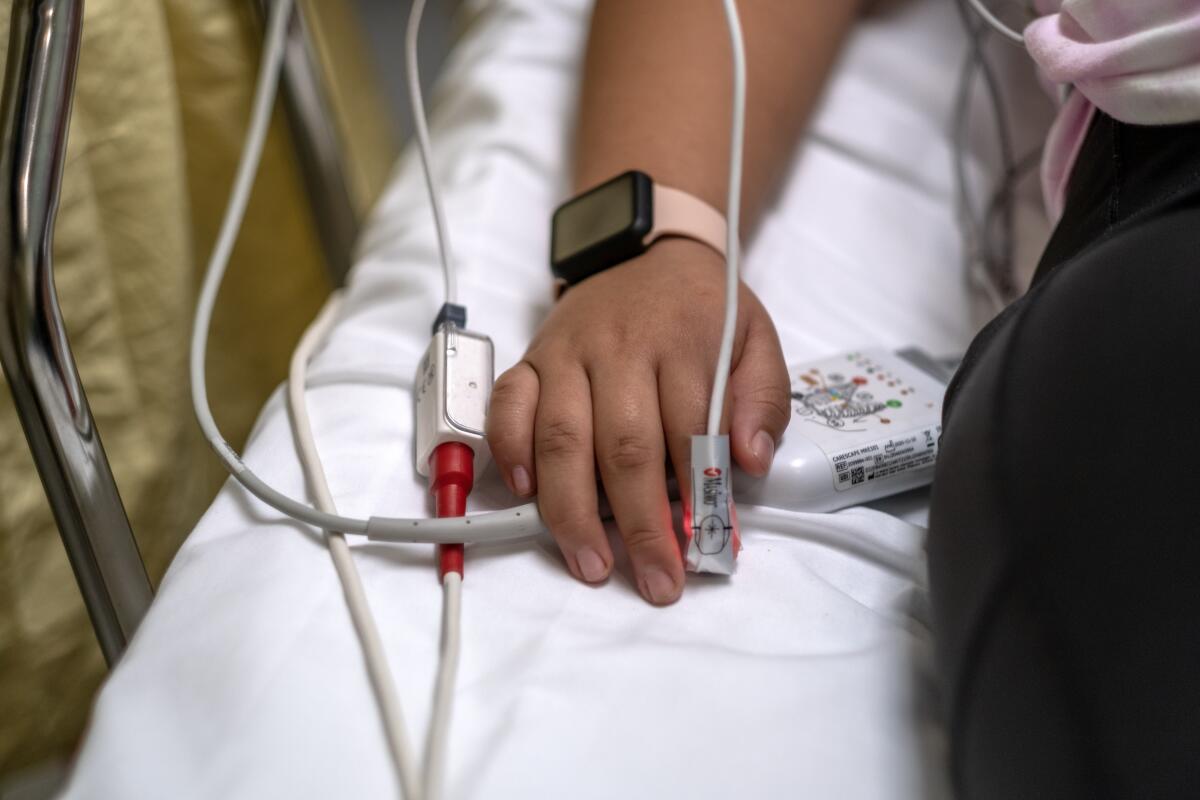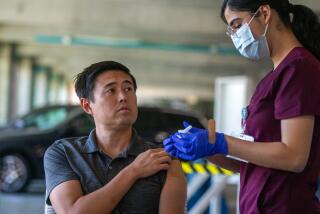California hospitals still stressed as flu, RSV, COVID remain at high levels

- Share via
The start of the year is bringing with it a mild reprieve in the so-called tripledemic, but some Southern California hospitals remain stressed by the still-high circulation of flu, COVID-19 and RSV.
Children’s Hospital Los Angeles is still so busy that it cannot always accommodate transfers of patients from other hospitals, according to Dr. James Stein, the facility’s chief medical officer, in a statement.
And hospitals in Orange County, California’s third-most populous, have been facing higher staff shortages over the prior week, with so many employees calling out sick, Orange County health officer Dr. Regina Chinsio-Kwong wrote in an email Thursday.
In Fresno County, the increased illness rates and the closure of a major area hospital combined to strain the region’s remaining hospitals, prompting the Board of Supervisors on Tuesday to declare a state of emergency.
Madera Community Hospital closed at midnight Monday amid financial struggles, with many of its patients absorbed by facilities in Fresno County.
But facilities in Fresno County were being overwhelmed even before the hospital’s closure, county staff said.
“Currently, the Fresno County hospital system is severely impacted by hospital overcrowding and operating significantly above normal and safe capacity,” the Fresno County staff wrote in a board agenda item.
Last week, Community Regional Medical Center was forced to divert patients to other facilities “due to the overwhelming receipt of persons accessing the emergency department and creating unsafe conditions within the hospital,” the staff wrote.
“It is highly likely that Fresno County will continue to experience a surge in the following weeks,” the staff wrote.
However, despite some continued strains, there are signs that conditions are improving. Statewide flu activity is still considered “very high,” according to the U.S. Centers for Disease Control and Prevention, but has notably improved from the start of December.
“After a quick severe start to this year’s flu season, it is a relief to see lower levels of flu activity,” said Los Angeles County Public Health Director Barbara Ferrer. “Nonetheless, it’s important to remain aware that the current level of flu activity, based on what we’re seeing from our surveillance lab, is still really high. So this year’s flu season [is] not yet over.”
Wastewater data from the L.A. County Department of Public Health suggest flu and respiratory syncytial virus, or RSV, have peaked and are beginning to decline.
Children’s Hospital Los Angeles is also reporting similar trends. The RSV positivity rate there is 10.6%, down from this season’s peak of 35.3% for the week of Oct. 23. The flu positivity rate at the pediatric hospital is 10%, down from the season’s peak of 18.6% for the week of Nov. 20, according to Dr. Michael Smit, the facility’s hospital epidemiologist and medical director of infection prevention and control.
However, it’s not a given that recent trends will continue through the early part of winter. Because L.A. County is “likely to continue to see high levels of flu activity,” Ferrer said Thursday, “we should be prepared for another peak later this winter after schools resume session.”
One of the best ways to thwart the flu is to get vaccinated, officials and experts say, and Ferrer noted that this year’s offering “is a good match for currently circulating strains, and it will provide important protection.”
In L.A. County, at least 23% of residents ages 6 months and older have received their seasonal flu shot, according to data reported in the government immunization registry. The figure is an underestimate, since reporting flu vaccine data to authorities is not mandatory; other estimates suggest the figure is probably closer to 40%, Ferrer said.
“It’s not too late to get the seasonal flu vaccine if you haven’t already done so,” she added.
The same goes for the coronavirus, which also remains at a heightened level despite recent declines. But recent declines may be leveling off, with transmission possibly increasing from Christmas gatherings.
L.A. County reported 2,350 coronavirus cases a day for the seven-day period that ended Tuesday, up 2% from the prior week. That’s still more than double the rate from the first week of November but significantly less than the autumn peak of 3,929 cases a day, recorded during the first week of December.
On a per capita basis, L.A. County’s latest coronavirus case rate is 163 cases a week for every 100,000 residents. A rate of 100 or more is considered high.
As with flu, officials say it’s possible there could be a second peak of COVID-19 in the new year as workers and students return from winter break.
The L.A. County Department of Public Health is urging workers and students to wear masks for at least 10 days in indoor public settings following their return to work and school, in hopes of blunting a possible second wave.
“Given that winter holiday travel and celebrations could lead to increased transmission, similar to what we experienced after the Thanksgiving holiday, we do continue to ask residents to layer in protections over the next few weeks — including masking, testing, frequent handwashing and staying home when sick,” Ferrer said. “These steps will also protect from other respiratory viruses that are circulating, including flu and RSV.”
Officials also recommend that residents avail themselves of bivalent COVID-19 boosters, which are designed to protect against the dominant Omicron subvariants. About 22% of eligible Californians have gotten the updated boosters, which became widely available starting in September.
So far in L.A. County, 20% of vaccinated residents ages 5 and older have received their updated bivalent COVID-19 booster. Among vaccinated seniors, 36% have received their updated shot.
“We are seeing some positive signs, and I believe that we all can play a role in helping to continue these trends into the new year,” Ferrer said.
More to Read
Sign up for Essential California
The most important California stories and recommendations in your inbox every morning.
You may occasionally receive promotional content from the Los Angeles Times.
















